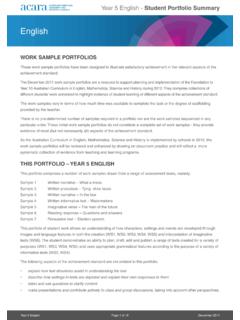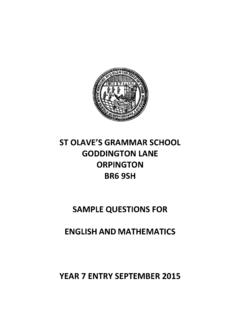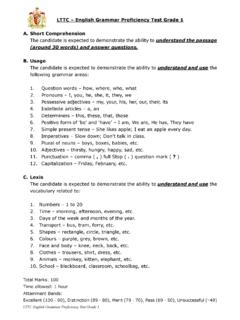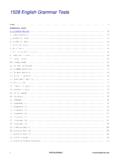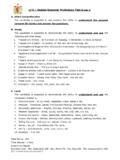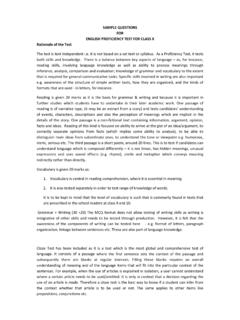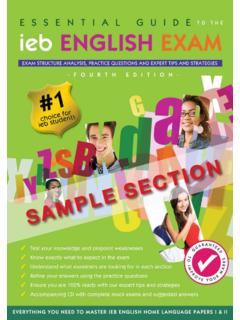Transcription of English - ACARA
1 Year 4 English - Student Portfolio Summary English WORK SAMPLE PORTFOLIOS. These work sample portfolios have been designed to illustrate satisfactory achievement in the relevant aspects of the achievement standard. The December 2011 work sample portfolios are a resource to support planning and implementation of the Foundation to Year 10 Australian Curriculum in English , Mathematics, Science and History during 2012. They comprise collections of different students' work annotated to highlight evidence of student learning of different aspects of the achievement standard. The work samples vary in terms of how much time was available to complete the task or the degree of scaffolding provided by the teacher. There is no pre-determined number of samples required in a portfolio nor are the work samples sequenced in any particular order.
2 These initial work sample portfolios do not constitute a complete set of work samples - they provide evidence of most (but not necessarily all) aspects of the achievement standard. As the Australian Curriculum in English , Mathematics, Science and History is implemented by schools in 2012, the work sample portfolios will be reviewed and enhanced by drawing on classroom practice and will reflect a more systematic collection of evidence from teaching and learning programs. THIS PORTFOLIO YEAR 4 English . This portfolio comprises a number of work samples drawn from a range of assessment tasks, namely: Sample 1 Response to literature What Katy Did Sample 2 Recount My favourite place Sample 3 Response to literature Storm Boy Sample 4 Persuasive text The best superpower to have is rewind Sample 5 Interview Jeannie Baker Sample 6 Reading response Fluency This portfolio of student work shows that this student is able to demonstrate understanding of how texts are structured differently depending on their audience and purpose (WS1, WS2, WS3, WS4, WS5).
3 The student makes connections between texts and own experiences (WS2, WS3, WS4, WS5) and expresses a substantiated point of view about a text (WS4). The student uses a variety of language features to develop descriptive and cohesive literary, informative and persuasive texts (WS1, WS2, WS3, WS4, WS5). The student collaborates with others to create clearly presented, engaging oral presentations (WS5, WS6). The following aspects of the achievement standard are not evident in this portfolio: create texts that show understanding of how images can be used to extend key ideas contribute actively to class and group discussions. Year 4 English Page 1 of 16 December 2011. Year 4 English - Work sample 1. English Work sample 1: Response to literature - What Katy Did Relevant parts of the achievement standard Receptive modes (listening, reading and viewing).
4 By the end of Year 4, students understand that texts have different text structures depending on purpose and audience. They explain how language features, images and vocabulary are used to engage the interest of audiences. They describe literal and implied meaning connecting ideas in different texts. They express preferences for particular texts, and respond to others' viewpoints. They listen for key points in discussions. Productive modes (speaking, writing and creating). Students use language features to create coherence and add detail to their texts. They understand how to express an opinion based on information in a text. They create texts that show understanding of how images and detail can be used to extend key ideas. Students create structured texts to explain ideas for different audiences.
5 They make presentations and contribute actively to class and group discussions, varying language according to context. They demonstrate understanding of grammar, select vocabulary from a range of resources and use accurate spelling and punctuation, editing their work to improve meaning. Summary of task Students were asked to choose a book to read and answer a number of questions in response to their chosen text. The students were provided with a worksheet titled Story grammar'. This work sample is a second draft that the student developed after editing a first draft with peers and the class teacher. Students were asked the following questions: What is the story about? What is the story trying to say? How did one event relate to another?
6 What is the author's point of view? Where does the story take place? How does the book's cover attract the audience's attention? Year 4 English Page 2 of 16 December 2011. Year 4 English - Work sample 1. English Work sample 1: Response to literature - What Katy Did Annotations Explains the different settings that are in the text, with the main setting being quite detailed through drawing on vocabulary from the text, for example a little marshy thicket at the bottom of the field'. Uses metalanguage to explain their response to the text, for example the author's intention is to get me hooked from the first chapter'. Lists the main characters and provides details about their priority. Evaluates the use of illustration. Sequences detailed events.
7 Expresses a point of view about the text. Uses noun groups/phases, for example shy, lovely girl' and prepositional phrases, for example at the bottom of the field near the house' to develop detailed sentences. Uses pronoun referencing correctly throughout the different parts of the text. Acknowledgment ACARA acknowledges the contribution of the trial school teachers and students for providing the tasks and work samples . The annotations are referenced to the Australian Curriculum achievement standards. Year 4 English Page 3 of 16 December 2011. Year 4 English - Work sample 2. English Work sample 2: Recount My favourite place Relevant parts of the achievement standard Receptive modes (listening, reading and viewing). By the end of Year 4, students understand that texts have different text structures depending on purpose and audience.
8 They explain how language features, images and vocabulary are used to engage the interest of audiences. They describe literal and implied meaning connecting ideas in different texts. They express preferences for particular texts, and respond to others' viewpoints. They listen for key points in discussions. Productive modes (speaking, writing and creating). Students use language features to create coherence and add detail to their texts. They understand how to express an opinion based on information in a text. They create texts that show understanding of how images and detail can be used to extend key ideas. Students create structured texts to explain ideas for different audiences. They make presentations and contribute actively to class and group discussions, varying language according to context.
9 They demonstrate understanding of grammar, select vocabulary from a range of resources and use accurate spelling and punctuation, editing their work to improve meaning. Summary of task This was part of an integrated unit based on the Australian National Parks and their importance to people. Students examined different text structures and language features that authors use when they recount events. Students were asked to write a recount of a visit to their favourite place and plan their writing first. They were also asked to edit their work by identifying words that they felt added descriptive, sequencing or connecting elements to their writing. These words are underlined in red. Year 4 English Page 4 of 16 December 2011. Year 4 English - Work sample 2.
10 English Work sample 2: Recount My favourite place Annotations Plans writing including important elements. Year 4 English Page 5 of 16 December 2011. Year 4 English - Work sample 2. English Work sample 2: Recount My favourite place Annotations Uses text structure appropriate for a recount, such as an elaborated introduction and correctly sequenced events, simple concluding paragraph including a personal reflection. Uses knowledge of spelling generalisations, for example when adding ing' including' and visual knowledge to spell words with ambiguous sounds, for example cause'. Uses appropriate language features, such as connectives to sequence ideas and to make the text more cohesive, for example families' and we'. Uses pronoun referencing to create cohesion.


